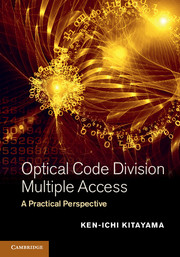1. Wellbrock G. and Xia R. J. (2010). The road to 100G deployment, IEEE Commun. Mag., March, S14–S18.
4. Sakano T. (2009). Intelligent optical networking to achieve customer satisfaction – Challenges and direction toward the future, OFC2009, NWB (Los Angeles, CA).
5. Vanier F. (2011). World Broadband Statics: Q1 2011, POINT topic.
6. Nagel S. R. (1987). Optical fiber – the expanding medium, IEEE Commun. Mag., 25; 4, 33–43.
7. Kao K. C. and Hockham G. A. (1966). Dielectric-fibre surface waveguides for optical frequencies, Proc. IEE, 113; 7, 1151–1158.
8. Suematsu Y. and Iga K. (2006). Introduction to Optical Fiber Communications (in Japanese), Tokyo: Ohmsha.
9. Kapron F. P., Keck D. B. and Maurer R. D. (1970). Radiation losses in glass optical waveguides, Appl. Phys. Lett., 17; 10, 423–425.
10. Itaya Y. (2008). Photonic Challenges Toward Future Broadband Society, ACP 2008, Plenary talk (Shanghai, China).
11. Morioka T., Jinno M., Takara H. and Kubota H. (2011). Revolutional optical transport technology in the future (in Japanese), NTT Technol. J., 23; 3, 32–36.
12. Morioka T., Awaji Y., Ryf R., Winzer P. and Richardson D. (2012). Enhancing optical communications with brand new fibers, IEEE Commun. Mag., February, S31–S42.
13. Takara H., Sano A., Kobayashi T., Kubota H., Kawakami H., Matsuura A., Miyamoto Y., Abe Y., Ono H., Shikama K., Goto Y., Tsujikawa K., Sasaki Y., Ishida I., Takenaga K., Matsuo S., Saitoh K., Koshiba M. and Morioka T. (2012). 1.01-Pb/s (12 SDM/222 WDM/456 Gb/s) Crosstalk-managed Transmission with 91.4-b/s/Hz Aggregate Spectral Efficiency, ECOC2012, Th.3.c.1 (Amsterdam).
14. Gregory G. Raleigh and Cioffi J. M. (1998). Spatio-temporal coding for wireless communication, IEEE Trans. Commun., 46; 3, 357–366.
15. Randel S., Sierra A., Mumtaz S., Tulino A., Ryf R., Winzer P. J., Schmidt C. and Essiambre R. J. (2012). Adaptive MIMO Signal Processing for Mode-division Multiplexing, OFC2012, OW3D.5 (Los Angeles, CA).
16. Koester C. J. and Snitzer E. (1964). Amplification in a fiber laser, Appl. Opt., 3, 1182–1186.
17. Stone J. and Burrus C. A. (1973). Neodymium-doped silica lasers in end-pumped fiber geometry, Appl. Phys. Lett., 23, 388–389.
18. Mears R. J., Reekie L., Poole S. B. and Payne D. N. (1985). Neodymium-doped silica single-mode fibre laser, Electron. Lett., 21, 738–740.
19. Roberts K., Beckett D., Boertjes D., Berthold J. and Laperle C. (2010). 100G and beyond with digital coherent signal processing, IEEE Commun. Mag., July, 62–69.
20. Okoshi T. and Kikuchi K. (1980). Frequency stabilization of semiconductor lasers for heterodyne-type optical communication schemes, Electron. Lett., 16; 5, 179–181.
21. Favre F. and LeGuen D. (1980). High frequency stability of laser diode for heterodyne communication systems, Electron. Lett., 16; 18, 709–710.
22. Yamazaki E., Yamanaka S., Kisaka Y., Nakagawa T., Murata K., Yoshida E., Sakano T., Tomizawa M., Miyamoto Y., Matsuoka S., Matsui J., Shibayama A., Abe J., Nakamura Y., Noguchi H., Fukuchi K., Onaka H., Fukumitsu K., Komaki K., Takeuchi O., Sakamoto Y., Nakashima H., Mizuochi T., Kubo K., Miyata Y., Nishimoto H., Hirano S. and Onohara K. (2011). Fast optical channel recovery in field demonstration of 100-Gbit/s Ethernet over OTN using real-time DSP, Opt. Express, 19; 14, 13179–13184.
23. Shannon C. E. (1949). Communication in the presence of noise, Proc. IRE, 37; 2, 10–21.
24. Duand L. B. and Lowery A. J. (2010). Improved single channel backpropagration for inta-channel fiber nonlinearity compensation in long-haul optical communication systems, Opt. Express, 18:2, 17075–17088.
25. Li L., Tao Z., Liu L., Yan W., Oda S., Hoshida T. and Rasmussen J. C. (2010). Nonlinear polarization crosstalk canceller for dual-polarization digital coherent receivers, OFC 2010, OWE3 (San Diego, CA, March 2010).
26. Mitra P. P. and Stark J. B. (2001). Nonlinear limits to the information capacity of optical fibre communications, Nature, 411, 1027–1030.
27. Essiambre R.-J. and Tkach R. W. (2012). Capacity trends and limits of optical communication networks, Proc. IEEE, 100; 5, 1035–1055.
28. Roberts P. J., Couny F., Sabert H., Mangan B. J., Williams D. P., Farr L., Mason M. W., Tomlinson A., Birks T. A., Knight J. C. and Russell P. S. J. (2005). Ultimate low loss of hollow-core photonic crystal fibres, Opt. Express, 13; 1, 236–244.
29. Collins B. C. (200). Wavelength Selectable Switches and Future Photonic Network Applications, PS 2009, FrII2–4 (Pisa, Italy).
30. Baran P. (2002). The beginning of packet switching: some underlying concepts, IEEE Commun. Mag., July, 42–48.
31. Miyahara H. (2001). Osaka University-NTT Meeting.
32. Recommendation ITU-T G.694.1 (02/2012). Figure I.1.
34. Hogari K., Yamada Y. and Toge K. (2010). Design and performance of ultra-high-density optical fiber cable with rollable optical fiber ribbons, Opt. Fiber Technol., 16, 257–263.
35. Muller S., Bechtolsheim A. and Hendel A. (2007). HSSG Speeds and Feeds Reality Check, IEEE 802.3 Higher Speed Study Group Meeting, January.

 Loading metrics...
Loading metrics...


